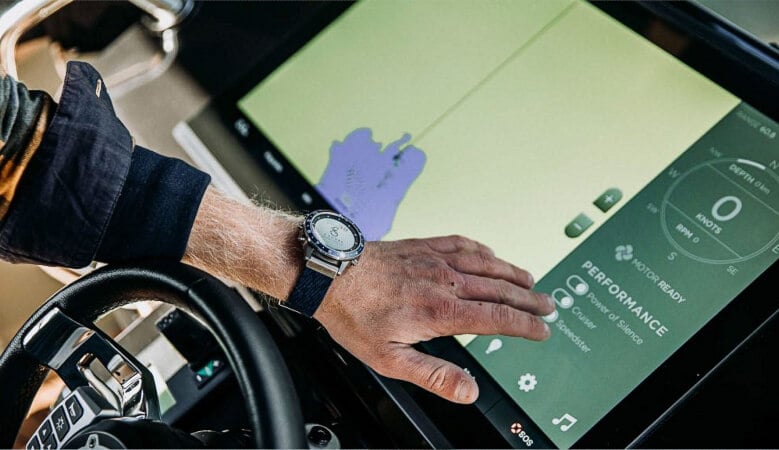Building the “Tesla of the Sea”
Boat builders vie for recognition with their high-end watercraft.
Trademark products and their names are said to become genericized when they get so popular and dominant in the market that their name starts to be used to describe the whole range of products. Think of Kleenex, Aspirin, Hoover, or Nintendo—all are examples of a trademark brand name that has come to represent a market segment.

Candela C8 EV hydrofoil. Image used courtesy of Candela
Build it Like Tesla
Is it possible that Tesla is beginning to reach that same level of market awareness? Lately, whenever a new electrically powered motorcycle, aircraft, boat, or other transportation concept is announced, it is invariably called the “Tesla of the (insert noun here).”
The goal is to imply that the new product from the startup will be as clever, innovative, and successful as the electric vehicle (EV) company—even if there is no direct or indirect connection between the products that may only exist as computer drawings and those of the world’s most highly capitalized automaker.
A good example of this is in the marine industry, where new watercraft that move away from gasoline or diesel internal combustion engines (ICEs) toward electrification of propulsion systems generates headlines. Everyone’s goal has become to attain the title of “Tesla of the Sea” by building electrically powered boats that mimic some of the features found on Tesla EVs.
It’s in the Battery Pack
How do you build a Tesla of the Sea?
Because your boat has to be powered by electricity, start with a lithium-ion battery. Unfortunately, batteries and anything else electronic don’t mix well with water. This is especially true with seawater, where salt-induced corrosion can rapidly degrade connectors, switches, and cables to the point they no longer work properly. While designers of land-based EVs put lots of effort into sealing batteries from the elements, special care must be taken for sea-going systems, particularly concerning waterproof venting designs.
Then there is the size of the pack. The pack must be large for an electrically powered boat to have a reasonable range of 50 miles or so between charges. The X-Shore Eelex 8000 electric boat, for example, has a 126 kilowatt-hour (kWh) battery that can power the craft up to 100 nautical miles when traveling at moderate to low speed. In contrast, the Candela C8 hydrofoil boat claims a 57 nautical mile range using a 69 kWh lithium-ion battery pack.
For comparison, a Tesla Model 3 Long Range has a 358-mile range from an 82-kWh lithium-ion battery pack.
Pushing a boat through the water differs from rolling a vehicle down a highway. On dry land, moving a car to speeds up to 80 mph requires moderate amounts of power from the electric motor to overcome the rolling resistance of the tires and the vehicle's aerodynamic drag.
To move a boat through the water, even at a moderately fast 20 mph, requires the vessel’s propellor to provide thrust by pushing against the water. The thrust from the propellor must overcome the viscous drag of the water on the hull, as well as any adverse tide or current flows that might exist. To accomplish this, the X-Shore, for example, has a 170-kilowatt (kW) motor and can reach a top speed of just over 30 mph, while the Tesla Model 3 has 258 kW of motive power available and can reach a 145-mph top speed.

Image used courtesy of X-Shore
Going Big With Technology
There are several serious electric boat makers. Some, like Duffy Electric Boats and Electracraft, have been around since the 1970s and specialize in building low-speed electrified boats for lakes and harbors. Others, like Pure Watercraft, specialize in outboard-powered vessels and conversions of existing ICE engines with electrified propulsion. To be a real contender for a title like Tesla of the Sea requires going big with technology.

Image used courtesy of X-Shore
The driving console has to have a big video screen—24 inches in the case of the X-Shore. Connectivity means your Tesla-like boat must talk to your watch, pad, or cell phone, allowing you to track its whereabouts, start it remotely, and even place it in a restricted mode to limit its performance when your child is at the helm.
Updates to the software take place automatically over the Internet, and autonomous modes will let the boat drive itself and help with docking. If, when you are wearing its special watch, you should fall overboard, the X-Shore will stop automatically and allow you to get back aboard. Candela pushes the envelope even further with its hydrofoil technology that enables the boat to rise above the surface of the water and travel above the waves on its retracting foils.
Pushing the Envelope to Become Tesla of the Sea
Although Tesla now has its (slightly more) affordable Model 3 and Model Y, it made its name as a premium brand with the Model S and Model X. Those who aspire to be named Tesla of the Sea should push the envelope both on exclusivity and price.
The Candela, for example, is made entirely from carbon fiber, which helps to explain at least part of its $390,000 price tag. The X-Shore uses carbon fiber for its roof and is priced at $329,000. Others are also pretenders to the Tesla of the Sea title.
With land transportation transitioning away from fossil fuels to electrification, it is a matter of time before weekend boaters follow suit. It won’t be these “Teslas of the Sea” they will be buying—the eye-watering price tags ensure that—but the market has to start somewhere.






